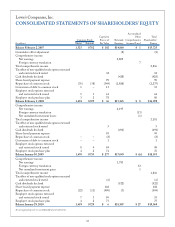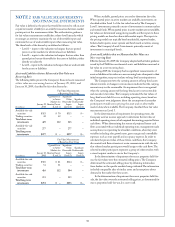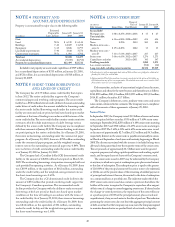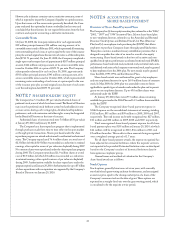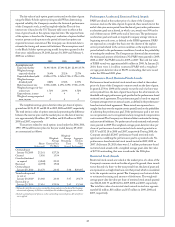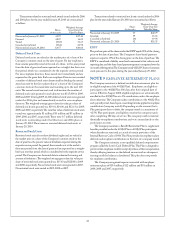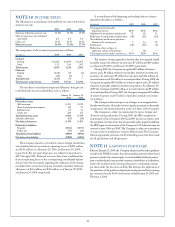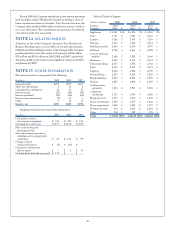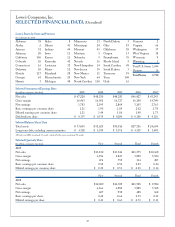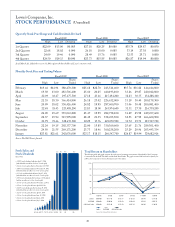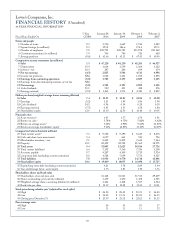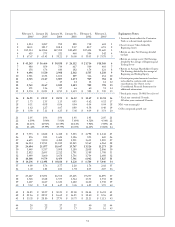Lowe's 2009 Annual Report Download - page 43
Download and view the complete annual report
Please find page 43 of the 2009 Lowe's annual report below. You can navigate through the pages in the report by either clicking on the pages listed below, or by using the keyword search tool below to find specific information within the annual report.
41
However, the indenture contains various restrictive covenants, none of
which is expected to impact the Company’s liquidity or capital resources.
Upon the issuance of the senior notes previously described, the Com-
pany evaluated the optionality features embedded in the notes and
concluded that these features do not require bifurcation from the host
contracts and separate accounting as derivative instruments.
Convertible Notes
On June 30, 2008, the Company redeemed for cash approximately
$19 million principal amount, $14 million carrying amount, of its
convertible notes issued in February 2001, which represented all remaining
notes outstanding of such issue, at a price equal to the sum of the issuance
price plus accrued original issue discount of such notes as of the redemption
date ($730.71 per note). On June 25, 2008, the Company completed a
single open-market repurchase of approximately $187 million principal
amount, $164 million carrying amount, of its senior convertible notes
issued in October 2001 at a price of $875.73 per note. e Company
subsequently redeemed for cash on June 30, 2008, approximately
$392 million principal amount, $343 million carrying amount, of its
senior convertible notes issued in October 2001, which represented all
remaining notes outstanding of such issue, at a price equal to the sum
of the issuance price plus accrued original issue discount of such notes
as of the redemption date ($875.73 per note).
NOTE 7 SHAREHOLDERS’ EQUITY
e Company has 5.0 million ($5 par value) authorized shares of
preferred stock, none of which have been issued. e Board of Directors
may issue the preferred stock (without action by shareholders) in one
or more series, having such voting rights, dividend and liquidation
preferences, and such conversion and other rights as may be designated
by the Board of Directors at the time of issuance.
Authorized shares of common stock were 5.6 billion ($.50 par value)
at January 29, 2010 and January 30, 2009.
e Company has a share repurchase program that is implemented
through purchases made from time to time either in the open market
or through private transactions. Shares purchased under the share
repurchase program are retired and returned to authorized and unissued
status. e Company repurchased 76.4 million shares at a total cost of
$2.3 billion (of which $1.9 billion was recorded as a reduction in retained
earnings, after capital in excess of par value was depleted) during 2007.
No common shares were repurchased under the share repurchase program
during 2008. e Company repurchased 21.9 million shares at a total
cost of $0.5 billion (of which $3 million was recorded as a reduction
in retained earnings, after capital in excess of par value was depleted)
during 2009. Authorization available for share repurchases under the
program expired as of January 29, 2010. Authorization for up to $5 billion
of share repurchases with no expiration was approved by the Company’s
Board of Directors on January 29, 2010.
NOTE 8 ACCOUNTING FOR
SHAREBASED PAYMENT
Overview of Share-Based Payment Plans
e Company has (a) four equity incentive plans, referred to as the “2006,”
“2001,” “1997” and “1994” Incentive Plans, (b) one share-based plan
to non-employee directors, referred to as the Amended and Restated
Directors’ Stock Option and Deferred Stock Unit Plan (Directors’
Plan) and (c) an employee stock purchase plan (ESPP) that allows
employees to purchase Company shares through payroll deductions.
ese plans contain a nondiscretionary antidilution provision that is
designed to equalize the value of an award as a result of an equity
restructuring. Share-based awards in the form of incentive and non-
qualified stock options, performance accelerated restricted stock (PARS),
performance-based restricted stock, restricted stock, restricted stock units,
and deferred stock units, which represent nonvested stock, may be granted
to key employees from the 2006 plan. No new awards may be granted
from the 2001, 1997, 1994 and the Directors’ Plans.
Share-based awards were authorized for grant to key employees
and non-employee directors for up to 169.0 million shares of common
stock. In May 2009, the 2006 plan was amended to remove limits
applicable to specific types of awards made under the plan and to permit
grants to non-employee directors. Up to 45.0 million shares were
authorized under the ESPP.
At January 29, 2010, there were 29.5 million shares remaining
available for grant under the 2006 Plan and 14.5 million shares available
under the ESPP.
e Company recognized share-based payment expense in
SG&A expense on the consolidated statements of earnings totaling
$102 million, $95 million and $99 million in 2009, 2008 and 2007,
respectively. e total income tax benefit recognized was $27 million,
$31 million and $32 million in 2009, 2008 and 2007, respectively.
Total unrecognized share-based payment expense for all share-
based payment plans was $105 million at January 29, 2010, of which
$64 million will be recognized in 2010, $36 million in 2011 and
$5 million thereafter. is results in these amounts being recognized
over a weighted-average period of 1.7 years.
For all share-based payment awards, the expense recognized has
been adjusted for estimated forfeitures where the requisite service is
not expected to be provided. Estimated forfeiture rates are developed
based on the Company’s analysis of historical forfeiture data for
homogeneous employee groups.
General terms and methods of valuation for the Company’s
share-based awards are as follows:
Stock Options
Stock options generally have terms of seven years, with normally
one-third of each grant vesting each year for three years, and are assigned
an exercise price equal to the closing market price of a share of the
Company’s common stock on the date of grant. ese options are
expensed on a straight-line basis over the grant vesting period, which
is considered to be the requisite service period.



